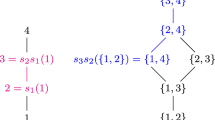Abstract
We consider the loci of invertible linear maps f : ℂn → (ℂn)* together with pairs of flags (E•, F•) in ℂn such that the various restrictions f : Fj → \( {E}_i^{\ast } \) have specified ranks. Identifying an invertible linear map with its graph viewed as a point in a Grassmannian, we show that the closures of these loci have cohomology classes represented by the back-stable Schubert polynomials of Lam, Lee, and Shimozono. As a special case, we recover the result of Knutson, Lam, and Speyer that Stanley symmetric functions represent the classes of graph Schubert varieties.
We consider similar loci where f is restricted to be symmetric or skew-symmetric. Their classes are now given by back-stable versions of the polynomials introduced by Wyser and Yong to represent classes of orbit closures for the orthogonal and symplectic groups acting on the type A flag variety. Using degeneracy locus formulas of Kazarian and of Anderson and Fulton, we obtain new Pfaffian formulas for these polynomials in the vexillary case. We also give a geometric interpretation of the involution Stanley symmetric functions of Hamaker, Marberg, and the author: they represent classes of involution graph Schubert varieties in isotropic Grassmannians.
Similar content being viewed by others
References
D. Anderson, Double Schubert polynomials and double Schubert varieties, https://people.math.osu.edu/anderson.2804/papers/geomschpolyn.pdf (2007).
D. Anderson, W. Fulton, Chern class formulas for classical-type degeneracy loci, Compos. Math. 154 (2018), no. 8, 1746–1774.
D. Anderson, W. Fulton, Degeneracy loci, Pfaffians, and vexillary signed permutations in types B, C, and D, arXiv:1210.2066v1 (2012).
E. Bagno, Y. Cherniavsky, Congruence B-orbits and the Bruhat poset of involutions of the symmetric group, Discrete Math. 312 (2012), no. 6, 1289–1299.
N. Bergeron, S. Billey, RC-graphs and Schubert polynomials, Experiment. Math. 2 (1993), no. 4, 257–269.
S. Billey, M. Haiman, Schubert polynomials for the classical groups, J. Amer. Math. Soc. 8 (1995), no. 2, 443–482.
S. Billey, W. Jockusch, R. P. Stanley, Some combinatorial properties of Schubert polynomials, J. Algebraic Combin. 2 (1993), 345–374.
A. Borel, Sur la cohomologie des espaces fibrés principaux et des espaces homogènes de groupes de Lie compacts, Ann. Math. 57 (1953), 115–207.
T. Bröcker, T. tom Dieck, Representations of Compact Lie Groups, Springer-Verlag, New York, 1985.
Y. Cherniavsky, On involutions of the symmetric group and congruence B-orbits of anti-symmetric matrices, Internat. J. Algebra Comput. 21 (2011), no. 5, 841–856.
W. Fulton, Flags, Schubert polynomials, degeneracy loci, and determinantal formulas, Duke Math. J. 65 (1992), no. 3, 381–420.
W. Fulton, Young Tableaux: With Applications to Representation Theory and Geometry, Cambridge University Press, Cambridge, 1997.
Z. Hamaker, E. Marberg, B. Pawlowski, Schur P-positivity and involution Stanley symmetric functions, Int. Math. Res. Notices 2019 (2019), no. 17, 5389–5440.
Z. Hamaker, E. Marberg, B. Pawlowski, Involution words: counting problems and connections to Schubert calculus for symmetric orbit closures, J. Combin. Theory Ser. A 160 (2018), no. 1, 217–260.
Z. Hamaker, E. Marberg, B. Pawlowski, Transition formulas for involution Schubert polynomials, Selecta Math. (N.S.) 24 (2018), no. 4, 2991–3025.
Z. Hamaker, E. Marberg, B. Pawlowski, Fixed-point-free involutions and Schur P-positivity, J. Combin. 11 (2020), no. 1, 65–110.
A. Hatcher, Algebraic Topology, Cambridge University Press, Cambridge, 2001.
X. He, K. Nishiyama, H. Ochiai, Y. Ōshima, On orbits in double flag varieties for symmetric pairs, Transform. Groups 18 (2013), 1091–1136.
J. Humphreys, Reflection Groups and Coxeter Groups, Cambridge University Press, Cambridge, 1990.
V. N. Ivanov, Interpolation analogs of Schur Q-functions, J. Math. Sci. 131 (2005), 5495–5507.
M. Kazarian, On Lagrange and symmetric degeneracy loci, preprint.
G. Kempf, D. Laksov, The determinantal formula of Schubert calculus, Acta Math. 132 (1974), 153–162.
A. Knutson, T. Lam, D. Speyer, Positroid varieties: juggling and geometry, Compos. Math. 149 (2013), 1710–1752.
T. Lam, S. J. Lee, M. Shimozono, Back stable Schubert calculus, Compos. Math. 157 (2021), 883–962.
A. Lascoux, M-P. Schützenberger, Polynômes de Schubert, C. R. Math. Acad. Sci. Paris 294 (1982), 447–450.
A. Lascoux, M-P. Schützenberger, Schubert polynomials and the Littlewood–Richardson rule, Lett. Math. Phys. 10 (1985), 111–124.
I. Macdonald, Symmetric Functions and Hall Polynomials, Oxford University Press, Oxford, 1995.
P. Pragacz, Algebro-geometric applications of Schur S- and Q-polynomials, in: Topics in Invariant Theory (Paris, 1989/1990), Lecture Notes in Math., Vol. 1478, Springer, Berlin, 1991, pp. 130–191.
R. P. Stanley, On the number of reduced decompositions of elements of Coxeter groups, European J. Combin. 5 (1984), no. 4, 359–372.
F. Szechtman, Equivalence and congruence of matrices under the action of standard parabolic subgroups, Electron. J. Lin. Alg. 16 (2007), 325–333.
R. Vakil, A geometric Littlewood–Richardson rule, Ann. of Math (2) 164 (2006), no. 2, 371–421.
M. Wachs, Flagged Schur functions, Schubert polynomials, and symmetrizing operators, J. Combin. Theory Ser. A 40 (1985), 276–289.
B. Wyser, K-orbit closures on G/B as universal degeneracy loci for flagged vector bundles with symmetric or skew-symmetric bilinear form, Transform. Groups 18 (2013), 557–594.
B. Wyser, A. Yong, Polynomials for symmetric orbit closures in the flag variety, Transform. Groups 22 (2017), 267–290.
Author information
Authors and Affiliations
Corresponding author
Additional information
Publisher’s Note
Springer Nature remains neutral with regard to jurisdictional claims in published maps and institutional affiliations.
Rights and permissions
About this article
Cite this article
PAWLOWSKI, B. UNIVERSAL GRAPH SCHUBERT VARIETIES. Transformation Groups 26, 1417–1461 (2021). https://doi.org/10.1007/s00031-021-09677-6
Published:
Issue Date:
DOI: https://doi.org/10.1007/s00031-021-09677-6



